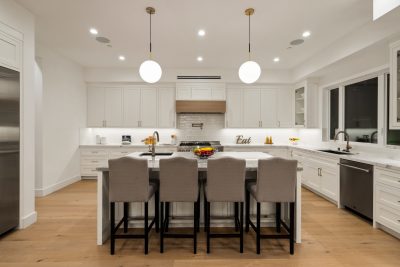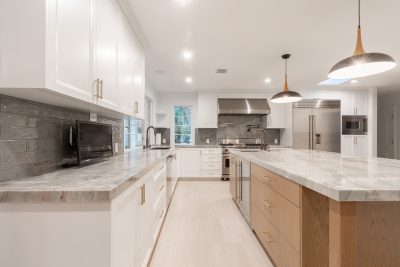
Remodeling a Kitchen or Bathroom in Los Angeles: A Guide
May 6, 2023
Introduction
In this article you will learn about remodeling a kitchen or bathroom. Our goal is to have a comprehensive guide to help you along your journey. We know embarking on a kitchen or bathroom remodeling project in Los Angeles is an exciting opportunity to enhance your living space. This comprehensive guide will cover everything from design inspiration to budgeting and permit requirements, ensuring your project runs smoothly from start to finish. Discover the latest trends, gather expert tips, and learn about the intricacies of the remodeling process to make your dream kitchen or bathroom a reality.
Exploring Design Trends for Kitchen and Bathroom Remodeling
Los Angeles offers a rich array of design trends to suit any taste. In this section, we’ll discuss modern minimalist styles, traditional elegance, and ways to customize your space for the perfect blend of form and function. We’ll also touch on the impact of sustainable materials and smart technology in contemporary designs.
Modern Minimalist Style
Modern minimalist design is all about clean lines, simple color palettes, and uncluttered spaces. This style often incorporates neutral colors, such as white, gray, and black, and emphasizes natural light and open spaces. Materials like stainless steel, glass, and engineered stone are commonly used to create a sleek, seamless look. Minimalist kitchens and bathrooms often feature handle-free cabinetry, wall-mounted fixtures, and hidden storage solutions to maintain a clutter-free environment.
Traditional Elegance
For those who prefer a more classic look, traditional design offers timeless elegance and charm. This style often features warm colors, ornate details, and rich materials like wood, marble, and brass. In a traditional kitchen or bathroom, you may find raised-panel cabinetry, decorative moldings, and vintage-inspired fixtures. Combining modern amenities with classic design elements can create a comfortable and inviting space that stands the test of time.
Customizing Your Space
Personalizing your kitchen or bathroom is key to making it truly yours. Consider incorporating unique design elements, such as custom cabinetry, statement lighting, or bold backsplashes, to express your individual style. You might also choose to integrate meaningful artwork, family heirlooms, or handcrafted tiles to add a touch of character and charm to your space.
Sustainable Materials and Smart Technology
Environmentally friendly materials and smart technology are increasingly popular in kitchen and bathroom design. Reclaimed wood, recycled glass, and eco-friendly countertops are just a few examples of sustainable materials that can be incorporated into your remodel. Smart technology, such as touchless faucets, energy-efficient lighting, and smart appliances, can add convenience and efficiency to your space while minimizing your environmental impact.
Smart Budgeting Tips for Your Remodel
Budgeting is key when remodeling a kitchen or bathroom. We’ll delve into setting a realistic budget, sourcing affordable materials, and repurposing existing fixtures to help you achieve a beautiful transformation without breaking the bank. Additionally, we’ll explore financing options and discuss the potential return on investment of your remodeling project.
Setting a Realistic Budget
Before starting your remodel, it’s important to establish a budget that takes into account your priorities and financial constraints. Begin by researching the average costs of kitchen and bathroom remodels in Los Angeles, and then create a list of must-haves and nice-to-haves. Allocate a portion of your budget for unexpected expenses, such as structural issues or permit fees, to avoid financial stress during the remodeling process.
Sourcing Affordable Materials
Shopping around for materials can help you find the best deals and stretch your budget further. Visit local showrooms, browse online retailers, and consider auction sites or salvage yards for discounted materials. You might also consider using budget-friendly alternatives, such as laminate countertops instead of quartz or porcelain tiles instead of natural stone.
Repurposing Existing Fixtures
Repurposing and refurbishing existing fixtures can be a cost-effective way to update your space without overspending. For example, consider refinishing or painting your existing cabinets, re-glazing an old bathtub, or refinishing hardwood floors. With a bit of creativity and elbow grease, you can give your kitchen or bathroom a fresh look without breaking the bank.
Financing Options
If your budget is tight, you may want to explore financing options for your remodeling project. Home equity loans, personal loans, and credit cards are all potential options, each with its own benefits and drawbacks. Be sure to research and compare interest rates, repayment terms, and any associated fees to make an informed decision that best fits your financial situation.
Return on Investment
While a kitchen or bathroom remodel can be a significant financial undertaking, it can also yield a high return on investment (ROI). According to industry experts, kitchen remodels can recoup between 60-80% of their cost, while bathroom remodels can yield an ROI of 50-70%. Keep this in mind when making decisions about materials and upgrades, as it can help you prioritize features that will add value to your home.
Navigating Permits and Regulations
Remodeling projects in Los Angeles often require permits. We’ll outline the types of permits you may need, guide you through the application process, and emphasize the importance of hiring licensed contractors to ensure your project meets all necessary regulations. We’ll also discuss zoning requirements and working with a building inspector.
Types of Permits Required
Depending on the scope of your project, you may need one or more permits from the city of Los Angeles. Common permits include building permits, plumbing permits, electrical permits, and mechanical permits. Projects that involve structural changes, such as adding or removing walls, will likely require a building permit. Similarly, updates to plumbing, electrical, or HVAC systems may necessitate additional permits.
Permit Application Process
To apply for permits, you’ll typically need to submit detailed plans, specifications, and any other required documentation to the Los Angeles Department of Building and Safety (LADBS). The LADBS will review your application and either approve, deny, or request modifications to your plans. Once your permits are approved, you’ll need to post them in a visible location on your property throughout the remodeling process.
Importance of Hiring Licensed Contractors
Hiring a licensed and insured contractor is crucial for ensuring that your project adheres to local building codes and regulations. Licensed contractors are knowledgeable about the permitting process and can help you navigate any necessary paperwork. Additionally, they carry liability insurance and worker’s compensation coverage, protecting you from potential legal and financial risks.
Zoning Requirements and Building Inspectors
Your remodeling project may also be subject to zoning requirements and inspections by a building inspector. Familiarize yourself with local zoning ordinances and work with your contractor to ensure your project is compliant. A building inspector will typically visit your property at various stages of the remodel to ensure that work is being done according to approved plans and in compliance with local building codes.
Selecting the Right Contractor for Your Project
Choosing the right contractor can make all the difference in your remodeling project. In this section, we’ll offer expert advice on vetting potential contractors, checking references, and verifying licenses and insurance to ensure you’re working with the best possible team. We’ll also discuss the importance of clear communication and setting expectations with your contractor.
Vetting Potential Contractors
Start your search for a contractor by asking for recommendations from friends, family, and neighbors who have completed similar projects. You can also search online for reputable contractors in your area. Compile a list of potential candidates and schedule interviews to discuss your project and evaluate their expertise, experience, and communication style. During the interview process, ask about their previous work on similar projects, their approach to problem-solving, and their familiarity with local building codes and permitting requirements.
Checking References and Past Work
Once you’ve narrowed down your list of potential contractors, it’s essential to check their references and review their past work. Ask for a list of recent clients and reach out to them to inquire about their experience with the contractor. Find out if the contractor completed the project on time, stayed within budget, and addressed any issues or concerns promptly. Additionally, ask to see examples of their completed projects, either through photographs or by visiting the site in person if possible.
Verifying Licenses and Insurance
Before hiring a contractor, verify that they are licensed and insured. Check the validity of their license through the California Contractors State License Board (CSLB) and ensure they have both general liability insurance and workers’ compensation coverage. Hiring a licensed and insured contractor protects you from potential legal and financial risks if something goes wrong during your project.
Clear Communication and Setting Expectations
Maintaining open and clear communication with your contractor is crucial for a successful remodeling project. Discuss your expectations regarding the project timeline, budget, and desired outcome upfront to avoid misunderstandings down the line. Schedule regular progress meetings and establish a preferred method of communication, such as phone calls, emails, or text messages, to stay informed and address any concerns promptly.
Negotiating Contracts and Setting Timelines
A detailed contract and realistic timeline can help your remodeling project stay on track. We’ll discuss drafting comprehensive contracts, establishing achievable timelines, and maintaining open communication to ensure a smooth and successful project.
Drafting a Detailed Contract
A well-drafted contract is essential for protecting both you and your contractor throughout the remodeling process. The contract should include a detailed description of the work to be performed, the materials to be used, a payment schedule, a timeline for completion, and any warranties or guarantees provided by the contractor. Be sure to review the contract thoroughly and address any questions or concerns before signing.
Establishing Realistic Timelines
Setting a realistic timeline for your remodeling project is crucial for managing expectations and ensuring a smooth process. Work with your contractor to develop a project schedule that takes into account factors such as permit approval, material lead times, and potential delays due to unforeseen issues. Be prepared to make adjustments to the timeline as needed and maintain open communication with your contractor to stay informed about any changes.
Maintaining Open Communication
As previously mentioned, open communication with your contractor is key to a successful remodel. Stay engaged throughout the process, ask questions, and address any concerns as they arise. Regular progress meetings can help you stay informed about the status of your project and provide an opportunity for you to provide feedback or request changes as needed.
Conclusion
With the right planning and execution, your kitchen or bathroom remodel in Los Angeles can be a rewarding experience. By following this comprehensive guide, you’ll be well-equipped to create a stunning, functional space that you’ll enjoy for years to come. As you embark on your remodeling journey, remember to prioritize your needs and wants, work with a reputable contractor, and maintain open communication to ensure your project is a success.


